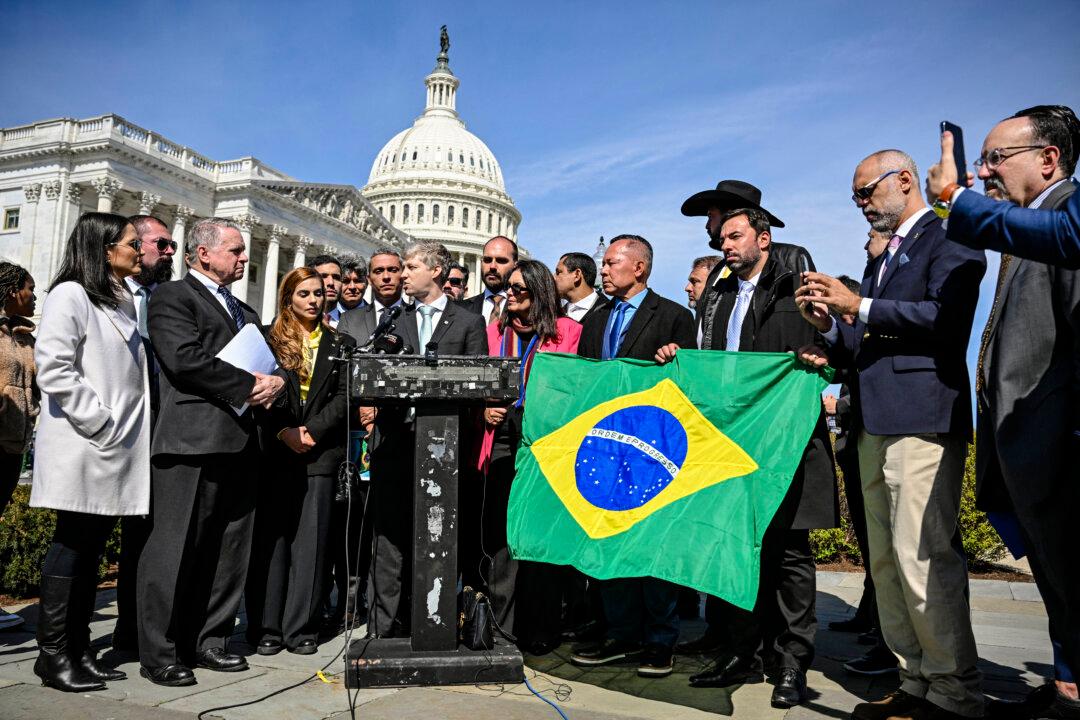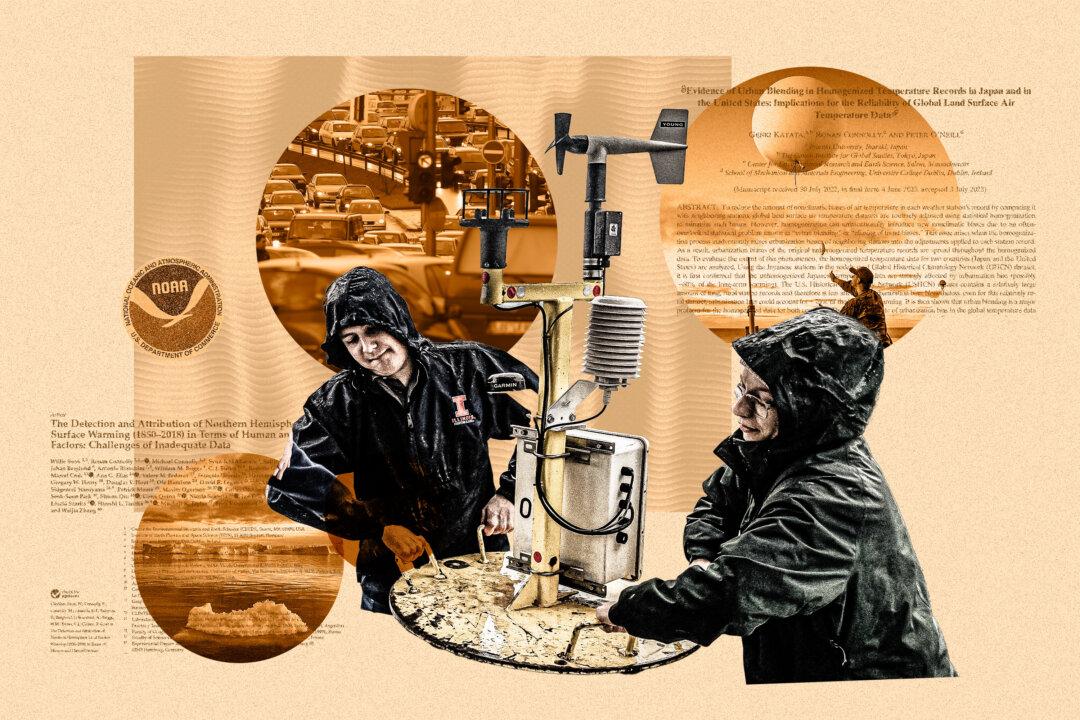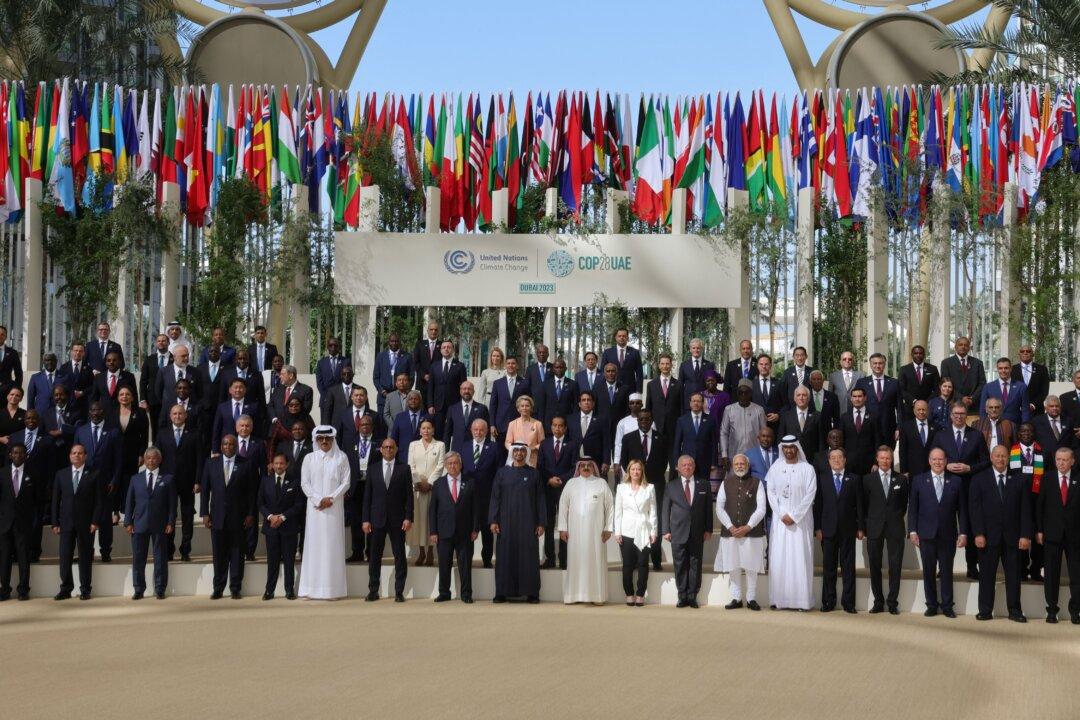A plan to boost global liquidity means the days of the U.S. dollar being the undisputed king of the international monetary system may be coming to a close, experts told The Epoch Times.
Losing that status could contribute to a serious crisis for the United States, involving a dramatic loss of economic purchasing power, a geopolitical realignment and everything associated with those shocks.
The Biden administration-backed International Monetary Fund (IMF) proposal to issue an unprecedented $650 billion worth of new “Special Drawing Rights” (SDRs) this year alone will also help reshape the international financial system.
That’s more than twice the total amount of SDRs created by the IMF throughout its entire history.
The SDR is a sort of proto-global currency, based on a basket of leading currencies, dubbed an “international reserve asset” by the IMF. Each government receives an amount of SDRs proportional to its stake in the international organization.
The unprecedented new issuance, which has the support of both Beijing and Washington, will contribute to sidelining the U.S. dollar’s role as the global reserve currency, analysts warned. The Chinese Communist Party is expected to be a leading beneficiary.
“The United States and our G-7 partners are actively considering a global effort to multiply the impact of the proposed Special Drawing Rights (SDR) allocation to the countries most in need,” the White House said in a statement.
For well over a decade, leading commentators and even political leaders around the world—including Communist Chinese central bank officials and numerous European leaders—have called for making the SDR into a true global currency.
Ostensibly aimed at making the world more “green” and “sustainable,” the shift would require a much larger role for the public sector at the national and international level while moving the world away from what remains of the free-market system. Widespread proliferation of new technologies associated with the “Fourth Industrial Revolution” are a critical component of the effort, too.
A restructuring of the international monetary system led by the IMF on the way to the globalization of currency—with the looming SDR issuance as a major step—is likely to play a key role in the global reset as well.
Just as significantly, the developments taking place at the IMF will empower global organizations to channel ever-larger sums of wealth from people in the United States and other major economies into projects selected by those organizations and their member governments.
Powerful global interests, for instance, are pushing to use the new SDR “allocation,” as the issuing of new SDRs is called, to finance everything from mass international COVID vaccinations to policy transformations around the world.
Experts and former officials also told The Epoch Times that the addition of a new layer of unbacked financial instruments on top of an already unstable global financial system would help further debase the world’s leading national currencies.
The implications are enormous—especially for the U.S. dollar and the global economy.
More Liquidity... or Instability?
Officially, the justification for the largest-ever round of SDR creation is to help boost liquidity for governments in poorer nations still reeling from economic chaos caused by governments’ responses to the CCP virus.But Holland-based Commodity Discovery Fund (CDF) founder Willem Middelkoop, author of the book “The Big Reset,” told The Epoch Times that the IMF plan has much broader significance.
“It’s clear the Biden administration is in favor of working together with the IMF and China to start using IMF’s balance sheet to create more ‘stimulus,’” said Middelkoop, a leading expert on the IMF and the SDR.
But there will be problems associated with the move, he said.
“By allowing the IMF to create $650 billion worth of new SDRs, central bankers are able to create another layer of fiat money to an already unstable financial system,” he said.
Among other concerns, Middelkoop warned that the plan would produce problems for the currencies that underpin the IMF’s SDRs, which include the U.S. dollar, the Japanese yen, the euro, the British pound, and the CCP’s yuan or renminbi, added in 2016.
“This will lead to more debasement of the five main world currencies, which are all part of the SDR-currency basket,” he said.
Indeed, Middelkoop warned years ago in his book on this subject that he expected the IMF to pursue more rounds of SDR creation, in ever-larger amounts.
At some point, once the allocation grows to a sufficient size, the U.S. Congress will have to be consulted for approval. But the $650 billion round being planned now is just below the statutory limit that would trigger congressional oversight.
The plan, according to the editorial, was to issue the SDRs in two stages—$650 billion this year and $350 billion next year—in an effort to bypass the U.S. legal requirement for congressional approval on such a large issuance.
When contacted by The Epoch Times, IMF officials denied that there was a plan to issue $350 billion in new SDRs next year, pointing to public statements by top IMF leaders.
However, if leading IMF member governments agree, there would be nothing to stop further issuance of SDRs next year or anytime after that.
IMF officials expect the $650 billion allocation to be complete by the end of the summer, they said.
U.S. Treasury Secretary Janet Yellen and G-20 governments including the CCP have all publicly indicated that they support the IMF plan.
The IMF executive board is expected to give its final approval so the issuance can be completed by the end of August, officials said.

What Is Really Going On?
Experts say that despite the complicated terminology, the IMF’s plans are not that difficult to understand.Think of the SDR issuance like printing money, but at the global level.
When the IMF creates SDRs, it is creating from thin air an instrument with purchasing power that allows the holder—typically a government—to purchase real goods and services. But instead of taxing citizens to seize that purchasing power, the IMF simply creates this sort of proto-global currency. Issuing new SDRs is basically the global equivalent of “quantitative easing” by a national central bank such as the Federal Reserve.
The primary difference is that instead of simply siphoning wealth from those holding U.S. dollars, as occurs when the Fed creates new dollars and dilutes the purchasing power of each existing dollar, the IMF issuance would also confiscate savings from those holding other major currencies in the basket that makes up the SDR. Another key difference is that when the Federal Reserve, for instance, creates new U.S. dollars, it lends them out and they can be spent immediately on goods and services.
For now, at least, SDRs must first be converted to U.S. dollars, euros, yen, yuan, or pounds before being spent on goods and services by the governments that receive the SDRs. The United States is obligated to exchange SDRs for dollars on demand.
Basically, by creating new “assets,” as the IMF refers to the SDRs, the international organization and its members are surreptitiously harvesting savings from humanity and redistributing those savings to the governments receiving SDRs.
Eventually, the IMF and many key world leaders hope to turn the SDR into a true global reserve currency, sidelining the U.S. dollar that currently occupies that role.
Top world leaders including then-Russian President Dmitry Medvedev, then-French President Nicolas Sarkozy, multiple U.N. agencies, and many others have openly announced their support for a new global currency in the wake of the last global financial crisis.
In 2009, the head of the CCP’s central bank at the time, Zhou Xiaochuan, also publicly called for the creation of a new international currency that would be disconnected from any single nation, with the SDR serving as the key candidate.
A report published on the CCP central bank’s website entitled “Reform the International Monetary System” explained that “the desirable goal of reforming the international monetary system, therefore, is to create an international reserve currency that is disconnected from individual nations and is able to remain stable in the long run, thus removing the inherent deficiencies caused by using credit-based national currencies.”
When asked about the CCP’s proposal at an event hosted by the powerful Council on Foreign Relations, then-U.S. Treasury Secretary Timothy Geithner summarized it as a plan to use SDRs more widely in the international monetary system.
“We’re actually quite open to that suggestion,” Geithner said, describing it as an “evolutionary” process.
In official reports, the UN and even the IMF itself have floated the idea of turning the SDR into a true global currency as well.
And now, the calls are growing louder and more public in the context of the current economic and health crises.
“Policymakers should negotiate some form of anchor—whether it’s tying each other’s currencies together, tying them to a central electronic currency or maybe electronic special drawing rights, the international reserve asset created by the IMF,” he wrote.
If the U.S. dollar were to lose its status as the global reserve currency, one of the immediate effects would be to crush the purchasing power of the U.S. dollar
Right now, governments, central banks, and businesses around the world keep large amounts of dollars on reserve to settle international transactions. This creates a constant global demand for the dollar.
However, if the dollar were to lose its status to the SDR, the demand for dollars around the world would plummet. The resulting collapse in purchasing power would create an enormous crisis as Americans’ ability to purchase goods and services from abroad was decimated.

Dethrone USD for China’s Benefit?
A former senior leader at a Bretton Woods institution who asked not to be identified due to concerns over potential retaliation in future employment told The Epoch Times he was “deeply concerned about the reserve currency status of the U.S. dollar.”Aside from the IMF plan, schemes by Beijing and other powers to undermine the U.S. dollar’s global dominance are also becoming more apparent. In fact, the former official believes the CCP’s digital currency is set to benefit to the point that it has “huge potential to dethrone the dollar.”
Like many other experts, the former official noted that the U.S. government’s large deficits and international debts are contributing to the problem.
But at the international level and in nations around the world, there is a desire to move beyond the dollar.
“If you polled senior leaders of all these institutions, there is little appetite for the U.S. dollar to be the global reserve,” he said, pointing to various motivations among officials worldwide.
“They believe in real globalism,” the former official said. “A lot of them believe we should all be ruled by the global equivalent of Brussels, where technocrats make decisions for everybody.”
While he personally believes in freedom and the nation-state, as well as allowing people to determine their own destiny, many at the IMF and the World Bank “believe they are exalted and brilliant people who know better than us, and that we should therefore trust them to develop rules for us,” the official said.
The CCP is a key player in the saga. “China is looking for a way to take the United States down,” said the official, who has extensive expertise in China and Chinese markets. “They view the U.S. as a speed bump on the road to global power.”
He believes the CCP would be happy to see the SDR supplant the U.S. dollar in the not-too-distant future, but that eventually the CCP would like to see its own currency become the global reserve.
“Their only currency is power—they can’t help themselves,” he said, contrasting the CCP with America’s “brilliant” founders who recognized that the power of politicians and political institutions needed to be limited for everybody’s protection.
Global Currency and Central Bank in the Making
Author and financial expert Jim Rickards, a leading authority on the IMF effort to turn the SDR into a global currency, said recently that the 2009 crisis SDR issuance by the IMF was an effort to “test the plumbing” and to “rehearse the governance, computational and legal processes for issuing SDRs.”In early 2011, the IMF even issued what Rickards described as “a master plan for replacing the dollar with SDRs.”
“This included creating an SDR bond market, SDR dealers, and ancillary facilities such as repos [repurchase agreement (repo) are for short-term borrowing of government securities], derivatives, settlement and clearance channels, and the entire apparatus of a liquid bond market,” he added, saying this was to help provide liquidity but also to ensure that the system was ready for “a large new issuance” on “short notice” if needed.
“The latest plan is for the IMF to combine forces with mega-banks, and big investors like BlackRock and PIMCO to implement the world money plan,” he continued.
In mid-June, Rickards warned that push for an “international monetary ’reset'” to sideline and ultimately replace the U.S. dollar was accelerating.
In fact, SDRs are already “basically world money,” said Rickards, an economist and investment banker who serves as editor of Strategic Intelligence and has published multiple books on these topics.
“The basic idea behind the SDR is that the global monetary system centered around the dollar is inherently unstable and needs to be reformed,” continued Rickards, considered one of the world’s leading experts on the subject.
Eventually, these SDRs will help fund all sorts of global projects, similar to how national central banks help their governments finance spending without having to raise taxes.
Dollar Trouble Inevitable
Speaking to The Epoch Times, South Bank Research’s Fortune and Freedom Editor Nick Hubble, an expert on the IMF and the SDR, noted that all reserve currencies, regardless of the underlying asset, ultimately fail. That is due to inbuilt biases leading to imbalances, he said.And he sees the growing effort to empower the IMF as a key factor in attempting to deal with this.
“The problems associated with the U.S. dollar being the global reserve currency have undermined the U.S. economy for decades now,” he said. “This has been driving many of the economic trends which are being blamed on anything but the true cause.”
The global shift away from the U.S. dollar as the global reserve will produce a “painful” economic crisis to begin with, Hubble explained. However, it may ultimately help the United States get its trade deficit under control, he continued.
“SDRs represent an attempt to transition away from this single national currency system to a multinational reserve currency—a basket of national currencies,” continued Hubble, who said he does not identify with any particular nation. “This will spread the economic pain between the currencies in the basket, and may well create a working solution for a few decades again.”
However, such a move would lead to new imbalances that would require a reworking in the future.
“The plan to make SDRs the next global reserve asset is the U.S. dollar’s best chance of avoiding a collapse as it nears the end of its shelf life in that function,” he argued. “U.S. dollars are a large part of the SDR bundle. But nations currently underrepresented in the SDR bundle are likely to demand a reshuffle of the SDRs weightings in exchange for adopting the system. And they hold the trump card that the U.S. dollar is on borrowed time.”
Currency resets are not new, and in fact occur every few decades, said Hubble, pointing to various examples throughout history.
“A transition away from the U.S. dollar as the global reserve asset would be nothing new,” he continued. “The only question is what it’ll be called and whether it’ll involve SDRs or some other asset.”
“It would be a managed decline of the U.S. dollar’s prominence, with leaders trying to maintain control,” Hubble added.
Asked about whether he was concerned about the power shift to the IMF that would result from allowing it to issue the new international reserve, Hubble noted that there is already a “rotating door between the IMF, treasuries, and central banks.”
As such, it would largely be the “same people” running the new system, he said.
Still, “international institutions do lack democratic accountability,” Hubble warned.
“A change in the global reserve may be both a symptom and a cause of the United States’ reduction in global power,” Hubble added, calling the dollar’s current status as the reserve currency a “mixed blessing.”

Golden Opportunity?
Another leading expert in the field, former managing director at Deutsche Bank and Lehman Brothers John Butler, suggested that the planned $650 billion SDR allocation was merely an effort by the IMF to remain relevant and keep up with the rapidly ballooning balance sheets of central banks around the world.“What this SDR issuance would do is grow the IMF balance sheet too, a ‘catching-up’ exercise as it were,” said Butler, who now works as an independent investment consultant and author.
The plan may help emerging markets deal with funding crises resulting from COVID lockdowns, he said.
But it will not significantly change the international reserve system or the U.S. dollar’s key role in it, he told The Epoch Times, acknowledging that his views are different from those of other experts in the field.
The IMF allocation would also benefit pharmaceutical companies involved in vaccine production.
“Whether that would indeed be the best use of such funds is largely subjective,” he said. “Some might argue that there are more cost-effective means of protecting public health, given that emerging-market COVID death rates are not particularly high relative to other causes such as basic nutrition and sanitation.”
Despite the very public moves to sideline the U.S. dollar as the global reserve asset in favor of turning the SDR into a true global currency, Butler said in a phone interview that he believed the IMF’s members were further from agreement on that today than 10 years ago.
In his view, rather than replacing the increasingly troubled current system with a new SDR-centric one, the world should look carefully at gold.
“As I write in my books, gold provides the only game-theoretical monetary equilibrium for a multi-polar, globalized world,” he said. “No one can print it or devalue it to benefit themselves at the expense of their trading partners.”
“It is the only truly objective, neutral, global money,” added Butler. “It does not require any government or group of governments to give it value or make it legal tender.”
Ultimately, he said in a phone interview, gold is the only real instrument that would adequately and fairly address the problems with the international monetary system.
“Hence I believe that, in future, gold will eventually displace the dollar as the dominant global reserve asset,” said Butler.
As has occurred with previous shifts in the system, it will likely take a crisis or series of crises to catalyze the shift to a gold-based international monetary regime.
But eventually, he believes a gold-backed monetary order will come—and it will be beneficial to all.
Spending the New SDRs
Once the IMF produces the new SDRs, assuming it goes through, governments and dictatorships will have wide latitude in how they spend the new “liquidity.”Some governments will even see a doubling of their foreign reserves under the plan.
So far, it is not clear what governments would use the new “liquidity” on.
Among other ideas, the report calls for using at least $100 billion of the $650 billion SDR issuance this year for helping the “developing world” to vaccinate the overwhelming majority of the population by the end of 2022.
When contacted by The Epoch Times for more information, IMF Senior Communications Officer Wafa Amr simply referred to various links on the IMF website and a statement put out by IMF chief Kristalina Georgieva late last month.
However, it appears from public statements that Georgieva is onboard with the Rockefeller-backed plan to funnel much of the “liquidity” to pharmaceutical giants through major vaccine purchases.
“If approved, a new allocation of SDRs would add a substantial, direct liquidity boost to countries, without adding to debt burdens,” said the Bulgarian IMF chief.
“It would also free up badly needed resources for member countries to help fight the pandemic, including to support vaccination programs and other urgent measures,” she continued, saying the plan would also “complement the range of tools deployed by the IMF to support our membership in this time of crisis.”
Biden also backs the plan. In a statement released last month, the White House expressed support for using up to $100 billion in SDRs to “further support health needs—including vaccinations.”
Final approval by the IMF board of governors is expected in the coming month.
The U.S. Treasury didn’t respond to repeated e-mail and phone requests for comment.





